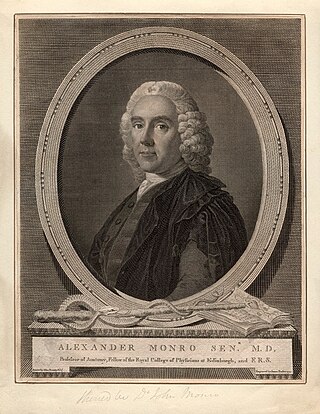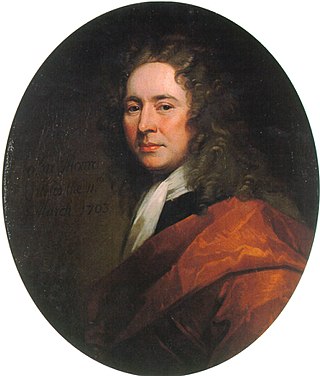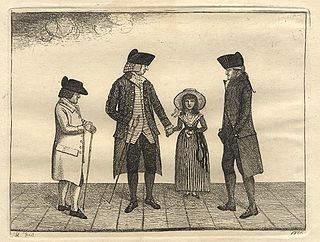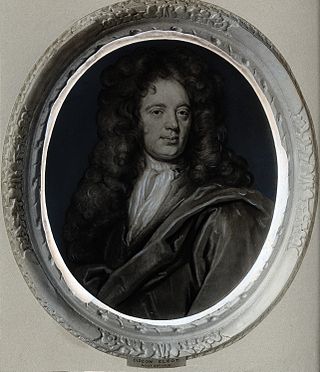
Alexander Monro III of Craiglockhart, FRSE FRCPE FSA (Scot) MWS, was a Scottish anatomist and medical educator at the University of Edinburgh Medical School. According to his detractors, Monro was an uninspired anatomist who did not compare with his brilliant father or grandfather as a teacher or scientist. His students included Charles Darwin who asserted that Monro "made his lectures on human anatomy as dull as he was himself."

Alexander Monro was a Scottish surgeon and anatomist. His father, the surgeon John Monro, had been a prime mover in the foundation of the Edinburgh Medical School and had arranged Alexander's education in the hope that his son might become the first Professor of Anatomy in the new university medical school.

John Monro of Bearcrofts (1670–1740) was a Scottish surgeon who was the progenitor of the Monro dynasty of anatomists in Edinburgh. He is credited with conceiving and playing a major role in founding the University of Edinburgh Medical School. He served as Deacon (President) of the Incorporation of Surgeons of Edinburgh.

Sir Robert Lauder of Beilmouth, Knt., was an armiger, lawyer and Clerk of Exchequer in Scotland. In 1683 he was made a Justice of the Peace for Haddingtonshire. In 1685, under the title Robert Lauder of Belhaven, he was a member of the Scottish parliament for Haddington, and in 1704 as Sir Robert Lauder of Beilmouth. He was also Commissioner of Supply for Haddington in 1689 and 1690.

The Munros of Auchinbowie are a distinguished branch of the Scottish, highland Clan Munro. From this family three Professors of Anatomy at the University of Edinburgh, Scotland were produced, as well as several other doctors and military officers.

Andrew Duncan, the elder FRSE FRCPE FSA (Scot) was a British physician and professor at the University of Edinburgh. He was joint founder of the Royal Society of Edinburgh. As first proposer of an asylum in Edinburgh he gives his name to the Andrew Duncan Clinic which forms part of the Edinburgh City Hospital.

John Lauder (1683–1737) was a Scottish surgeon, who was Deacon (President) of the Incorporation of Surgeons of Edinburgh for four separate terms of office. His portrait c.1700 by the artist William Aikman (painter) is on display at the Royal College of Surgeons of Edinburgh.

James Rae (1716–1791) was a Scottish surgeon, known as the earliest lecturer on surgery in Edinburgh and with a particular reputation as a dental surgeon.

Gilbert Primrose was a Scottish surgeon who became Surgeon to King James VI of Scots and moved with the court to London as Serjeant-Surgeon to King James VI and I on the Union of the Crowns. He was Deacon of the Incorporation of Surgeons and Barbers of Edinburgh on three occasions.

James Russell FRSE RSA (1754–1836) was a Scottish surgeon who was the first professor of clinical surgery at the University of Edinburgh. He was president of the Royal College of Surgeons of Edinburgh and was a co-founder of the Royal Society of Edinburgh. In 1805 he published one of the earliest descriptions of direct inguinal hernia. His collection of anatomical specimens was donated to the Surgeon's Hall in Edinburgh and is now known as the James Russell Collection.
Christopher Irvine of Bonshaw was a Scottish physician and surgeon who was the first medically qualified member of the Incorporation of Surgeons and Barbers of Edinburgh. A prolific author, he became historiographer to King Charles II and to King James II and VII.

James Borthwick of Stow was a Scottish surgeon who was the first teacher of anatomy in the Incorporation of Surgeons and Barbers of Edinburgh. He was Deacon (President) of the Incorporation on two occasions and a member of the Scottish Parliament. Borthwick was largely responsible for the formal creation of the surgeon-apothecary in Edinburgh.
John Naysmith was a Scottish surgeon who became surgeon to King James VI of Scotland and was appointed Royal Herbalist in London when the monarch became King James VI and I at the Union of the Crowns. He was Deacon (President) of the Incorporation of Surgeons and Barbers of Edinburgh.

Gideon Eliot (1664-1713) of North Sintoun in Roxburghshire was an Edinburgh surgeon. He served as surgeons to the 26th Regiment of Foot. He was elected Deacon (President) of the Incorporation of Surgeons of Edinburgh on two occasions.

The Incorporated Trades of Edinburgh are the trade and craft bodies of the City of Edinburgh, Scotland, in much the same way as the Livery companies are in The City of London, but on a much smaller scale. The Incorporations are not "guilds", that term being properly reserved in Scotland for the merchant bodies in the various burghs. The Incorporations have never referred to themselves as guilds; indeed they came into existence, mostly in the latter part of the fifteenth century, in order to counter the growing power of the merchant guild, known as the Royal Company of Merchants of the City of Edinburgh.
Alexander Monteith of Auldcathie (1660–1713) was an Edinburgh surgeon, who in his three terms as deacon (president) of the Incorporation of Surgeons of Edinburgh, presided over some of the most important changes in its history. These included obtaining the rights to perform anatomical dissection on the bodies of prisoners dying in jail, the granting of a royal charter by William and Mary in 1695, and the construction of the original Surgeons' Hall, the first permanent home of the Edinburgh Surgeons.

Adam Drummond of Binend (1679-1758) was a Scottish surgeon-apothecary who was appointed, jointly, as the first Professor of Anatomy at the University of Edinburgh.
Sir William Binning of Wallyford (1637–1711) was a 17th-century Scottish landowner who served as Lord Provost of Edinburgh from 1675 to 1677.
George Lauder, was an Edinburgh surgeon who was deacon (president) of the Incorporation of Surgeons of Edinburgh in 1744. During the Jacobite rising of 1745-46 he cared for the wounded after the Battle of Prestonpans, acted as surgeon with the Jacobite army on its march into England and retreat to Scotland, where he cared for wounded after the Battle of Falkirk.














